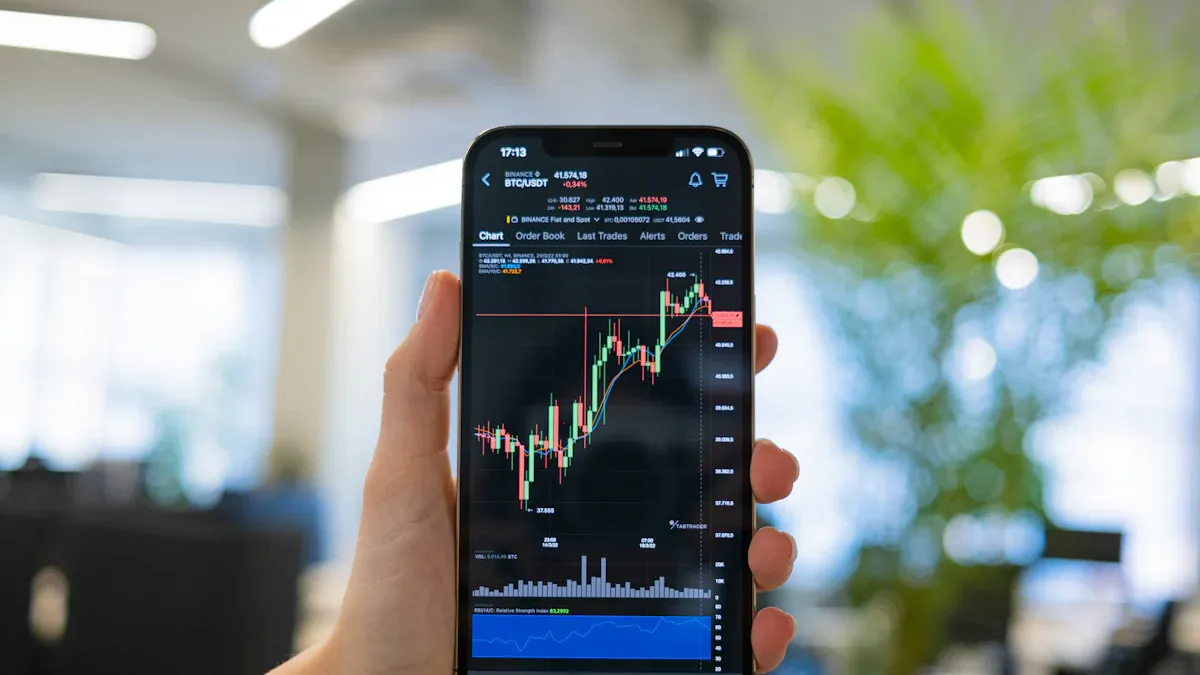- EasyCard
- Trade
- Help
- Announcement
- Academy
- SWIFT Code
- Iban Number
- Referral
- Customer Service
- Blog
- Creator
How to Correctly Set Stop-Loss Orders in U.S. Stock Trading

Image Source: pexels
In U.S. stock trading, stop-loss orders can help you effectively control risk. You need to set clear stop-loss price levels, follow discipline, and reduce unnecessary losses. Stop-loss orders not only protect your capital but also help you stay calm during market fluctuations. You should choose a stop-loss strategy based on your investment style and risk tolerance.
Key Points
- Stop-loss orders effectively control risk in U.S. stock trading, protect capital, and help you stay calm during market fluctuations.
- Market stop-loss orders execute quickly but have uncertain prices, limit stop-loss orders ensure prices but may not execute, and trailing stop-loss orders can automatically lock in profits.
- When setting stop-loss prices, you can use the percentage method, fixed amount method, or support level method, adjusting flexibly based on personal risk tolerance and market volatility.
- Avoid frequently modifying stop-loss orders due to emotions, strictly adhere to stop-loss discipline, and stay rational to steadily improve investment returns.
- Choose stop-loss strategies and position sizes based on your investment style and money management principles to ensure long-term stable trading.
Types of Stop-Loss Orders

Image Source: pexels
In U.S. stock trading, you can choose different types of stop-loss orders to manage risk. Each type has distinct triggering mechanisms and applicable scenarios. The table below helps you quickly understand the definitions and triggering mechanisms of three common stop-loss orders:
| Stop-Loss Type | Definition | Triggering Mechanism |
|---|---|---|
| Market Stop-Loss Order | When the price reaches the preset stop-loss price, it automatically converts to a market order to execute, preventing excessive price declines and enabling timely loss limitation. | After the price hits the stop-loss price, the broker’s system converts the order to a market order and submits it to the exchange for execution. |
| Limit Stop-Loss Order | When the price reaches the stop-loss price, it converts to a limit order, restricting the transaction price range to avoid slippage risk. | After the price hits the stop-loss price, the broker’s system converts the order to a limit order and submits it to the exchange for execution. |
| Trailing Stop-Loss Order | The stop-loss price automatically adjusts with favorable market price movements, protecting profits while limiting losses. | The stop-loss price dynamically adjusts; when the price hits the adjusted stop-loss price, it automatically triggers a market or limit order for execution. |
Market Stop-Loss Order
You can use a market stop-loss order to automatically sell stocks at the market price when the stock price falls to a certain level. This helps you limit losses promptly and prevent further loss expansion. For example, you buy a stock at $820, and the price rises to $840. To protect your profits, you can set a sell stop-loss order at $830. If the stock price falls back to $830, the system will automatically sell at the market price. Market stop-loss orders are suitable for highly liquid stocks, with the advantage of fast execution but the drawback of potential execution prices lower than the stop-loss price, especially during high market volatility, which may cause slippage. You can also use buy stop-loss orders to automatically buy when the stock price breaks above a certain level, suitable for breakout strategies.
Limit Stop-Loss Order
A limit stop-loss order, upon triggering the stop-loss price, places a limit order at your specified price. This ensures the transaction price is not lower (for selling) or higher (for buying) than your expectation. For example, you hold a stock at $50. You can set a stop-loss price at $48 and a limit price at $47.5. When the stock price falls to $48, the system will place a limit order to sell at $47.5. If the market price falls below $47.5, the order may not execute. Limit stop-loss orders are suitable when you have strict price requirements but may miss the stop-loss opportunity.
Tip: Market stop-loss orders ensure execution but not price; limit stop-loss orders ensure price but not execution. You need to choose based on your risk preferences.
Trailing Stop-Loss Order
A trailing stop-loss order allows the stop-loss price to automatically adjust upward as the stock price rises, helping you lock in profits. For example, after buying a stock, you set a 5% trailing stop. As the stock price rises, the stop-loss price rises accordingly. If the stock price falls more than 5%, the system automatically sells. Trailing stop-loss orders are suitable for protecting profits in favorable market conditions while limiting losses.
You can also choose buy stop-loss or sell stop-loss orders based on your trading direction. Buy stop-loss orders automatically buy when the stock price rises to a specified level, preventing you from missing an upward trend. Sell stop-loss orders automatically sell when the stock price falls to a specified level, protecting existing profits or limiting further losses.
Setting Stop-Loss Orders in U.S. Stock Trading

Image Source: pexels
In U.S. stock trading, scientifically setting stop-loss orders can help you effectively control risk and protect capital. You can choose different stop-loss setup methods based on your investment style and risk tolerance. Common methods include the percentage method, fixed amount method, and support level method. Below, we detail the procedures and precautions for each method.
Percentage Method
The percentage method is one of the most commonly used stop-loss setups in U.S. stock trading. You can set a fixed loss percentage as the stop-loss point based on the purchase price. For example, you buy a stock at $100 and decide the maximum acceptable loss is 5%. The stop-loss price would then be $95. When the stock price falls to $95, the system automatically triggers the stop-loss order to limit losses.
This method is suitable for most investors, simple to operate, and easy to execute. You can adjust the percentage based on market volatility and personal risk preferences. For highly volatile stocks, you can widen the stop-loss percentage to avoid frequent triggering due to short-term fluctuations. If you prioritize capital safety, choose a smaller percentage.
Tip: You can set the stop-loss price based on holding costs. Using holding costs as a benchmark, combine stop-loss points to calculate the trigger price, ensuring the stop-loss price reasonably reflects your actual costs.
Fixed Amount Method
The fixed amount method involves setting the stop-loss price based on the maximum loss amount you can tolerate per trade. This method helps you strictly control single-trade losses, preventing significant losses from a single mistake. You can refer to the table below to choose appropriate stop-loss amount ranges based on different trading cycles:
| Trading Cycle | Stop-Loss Amount Range (Loss Percentage) |
|---|---|
| Ultra-Short-Term (T+1) | 1.5% - 3% |
| Short-Term (~5 days) | 3% - 5% |
| Medium to Long-Term | 5% - 10% |
For example, if you plan short-term trading with a purchase price of $200 and a maximum acceptable loss of 4%, you can set the stop-loss price at $192. If using a fixed price retracement trailing stop, you can set the stop-loss point based on a price drop of no more than 8% from the highest point. You can flexibly adjust based on your capital size and risk tolerance.
Note: You should set the stop-loss price based on the maximum tolerable loss amount to avoid losses exceeding your psychological or financial capacity.
Support Level Method
The support level method uses technical analysis tools to set stop-loss points at key price levels. This method is suitable for investors with some technical analysis knowledge. You can follow these steps:
- Use the hourly chart as the primary basis for entry and exit, referencing support and resistance levels from weekly charts to set stop-losses, ensuring they are not easily triggered. For investors with average capital, focus on hourly charts to avoid low capital efficiency and excessive risk from daily or weekly chart trading.
- When setting stop-loss levels, never exceed the maximum acceptable loss (e.g., 20 points). You can set the stop-loss just below the breakout candlestick based on historical data patterns that align with specific profitable trends.
- You can combine adjacent candlestick patterns, 5- and 18-period moving averages, and the average of the highest and lowest prices within a range to simplify technical indicators and assist in determining entry and exit timing.
- Set the stop-loss immediately upon entry, rather than passively waiting for it to trigger. If the trend does not validate your entry rationale, exit promptly with active stop-losses to reduce loss risk.
- By analyzing historical data for successful profitable patterns, determine reasonable stop-loss ranges and entry/exit signals, keeping the trading system simple and actionable.
Tip: You can use key support levels and price retracement ratios (generally not exceeding 5%) as the basis for setting stop-loss points, ensuring they align with market key levels and reasonable loss ranges.
Stop-Loss Order Execution Timing and Additional Features
You need to note that stop-loss orders are typically executed only during U.S. stock trading hours. Some brokers support extended-hours stop-loss orders, but liquidity and execution prices may be affected. You can also use conditional orders and combined stop-loss/take-profit functions to enhance risk management efficiency. For example, you can set stop-loss and take-profit orders to activate simultaneously, automatically locking profits and controlling losses.
How to Set Stop-Loss Prices Based on Your Situation
You can set stop-loss prices based on the following points:
- Use holding costs as a benchmark, combining stop-loss points to calculate the trigger price.
- Adjust the stop-loss range based on market volatility. If uncertain about the trading direction, narrow the stop-loss range; if confident in the direction but unsure of timing, widen it slightly.
- Use key support levels and price retracement ratios as the basis for setting stop-loss points.
- Set the stop-loss price based on the maximum tolerable loss amount, reflecting your risk preferences.
- After a stop-loss is triggered, you can choose different order price types (e.g., market or best available price), affecting the actual execution outcome of the stop-loss price.
By scientifically setting stop-loss orders, you can better control risk in U.S. stock trading, improve capital efficiency, and maintain a sound trading mindset.
Precautions
Stop-Loss Point Setup
When setting stop-loss orders in U.S. stock trading, you may encounter common pitfalls. Here are three typical mistakes investors make:
- You may believe losses can be “waited out”, holding onto hope and delaying stop-losses, missing the optimal timing and causing losses to grow.
- You may stop losses frequently, lacking consistency and confidence, leading to repeated losses and difficulty forming an effective stop-loss plan.
- You may handle small losses but hesitate with large losses, resulting in increasingly significant losses.
You must remember that every trade has an optimal stop-loss timing. Decisively executing stop-loss discipline effectively controls risk and protects capital. Rationally setting stop-loss orders helps you overcome emotional trading and enhances the stability of long-term investment returns.
Market Volatility Impact
Market volatility directly affects the likelihood of stop-loss order triggers. Higher volatility increases the chance of stop-loss orders being triggered. You can adopt dynamic stop-loss strategies, adjusting the stop-loss distance based on market volatility. For example, during high volatility, widen the stop-loss distance to reduce the risk of being stopped out by short-term fluctuations. Trailing stops are suitable for clear trend markets, typically set at 2% to 5% of the current price. You should flexibly adjust stop-loss strategies based on actual U.S. stock market volatility to control risk while protecting profits.
Risk of Frequent Modifications
If you frequently modify stop-loss orders, you may be flagged by the exchange for abnormal trading behavior. This can lead to risks such as trading restrictions, disrupted capital operations, or being placed on a regulatory watchlist. You should avoid frequently adjusting stop-loss points due to emotional fluctuations, stay calm, and stick to your investment plan. Rational decision-making, combined with your risk tolerance and investment goals, enables long-term stable returns in U.S. stock trading.
Risks and Limitations
Execution Risk
When using stop-loss orders in U.S. stock trading, you may face execution risks. Stop-loss orders do not guarantee execution. During rapid market price movements, stop-loss orders may be “swept,” resulting in actual execution prices significantly different from the preset stop-loss price, a phenomenon called slippage. Slippage is common during low market liquidity or price gaps, especially during major economic data releases or Federal Reserve interest rate decisions. You may also encounter situations where orders fail to execute at the expected price. You can reduce slippage risk by choosing platforms with high liquidity, using limit orders, or stop-limit orders. However, even then, slippage is hard to avoid entirely in extreme market conditions.
Extreme Market Conditions
In extreme market conditions, the limitations of stop-loss orders become more pronounced. Here are common real-world scenarios:
- During major economic data releases, market prices gap instantly, triggering stop-loss orders but executing at prices far below expectations, leading to larger losses.
- Large institutions may sometimes push prices to trigger a large number of stop-loss orders, achieving their own profit-taking exits, a phenomenon known as “stop hunting.”
- Slippage is part of trading costs, with positive and negative slippage equally likely. You need to view slippage rationally to avoid cognitive bias.
- Brokers do not always engage in stop hunting; slippage is unavoidable in extreme conditions, and market stop-loss orders cannot fully mitigate risk.
You should pay special attention to risk management in extreme market conditions, setting stop-loss orders reasonably to avoid significant losses due to sharp market fluctuations.
Psychological Impact
The setup of stop-loss orders significantly affects your trading psychology. You can refer to the table below to understand the psychological impact of different stop-loss strategies:
| Situation | Stop-Loss Price Setup | Advantages | Disadvantages |
|---|---|---|---|
| Low Risk Tolerance | Closer | Quick loss limitation, reduced losses | May close positions too early, missing profit opportunities |
| High Risk Tolerance | Farther | Opportunity for larger profits | May face larger losses |
| Technical Analysis-Based | Based on support/resistance levels | Aligns with market trends, improves stop-loss effectiveness | Technical analysis has some margin of error |
| Market Volatility Consideration | Wider during high volatility, tighter during low volatility | Adapts to market characteristics, avoids false triggers | Inaccurate volatility judgment affects stop-loss effectiveness |
By reasonably setting stop-loss orders, you can overcome emotional disturbances like fear, greed, and anxiety, avoiding deviations from your trading plan. You should understand that trading failures are not solely due to psychological issues but may also stem from analysis errors or improper stop-loss setups. U.S. stock trading requires you to decisively stop losses when losing and take profits promptly when gaining, maintaining rationality and strictly adhering to trading discipline.
Strategy Selection
Matching Investment Style
When choosing a stop-loss strategy in U.S. stock trading, you first need to clarify your investment style. Different styles have different stop-loss requirements:
- Short-Term Trading: You aim for quick profits, typically holding positions for a few days to a couple of weeks. You need to rely on technical analysis and market hotspots, with higher risk. You should set strict stop-loss points, limiting losses quickly to prevent small losses from becoming large.
- Swing Trading: You focus on trend changes, holding positions for weeks to months. You can combine technical and fundamental analysis, with relatively flexible stop-loss strategies. You can adjust stop-loss distances based on market sentiment and hotspots.
- Medium to Long-Term and Long-Term: You prioritize company fundamentals and long-term value, holding positions for months to years. You can set looser stop-loss points, focusing more on safety margins and long-term returns.
You should also consider institutional behavior and buying motives. If you engage in speculative buying, stop losses decisively when prices fall. For investment-based buying, you can consider adding to positions to lower costs. Your risk tolerance is also critical. Conservative investors lean toward stopping losses, while aggressive investors may opt to add to positions. When positions are too heavy, stop losses promptly; when positions are light, consider moderate additions.
Tip: Regardless of style, strictly adhering to stop-loss discipline and combining trailing stop strategies can help you lock in profits and control risk.
Money Management
In U.S. stock trading, money management is the core of protecting capital and controlling risk. You can adopt the following methods:
- Control single-trade loss amounts to avoid significant losses from a single mistake. You can set the maximum loss per trade to not exceed 2%-3% of account funds.
- Allocate positions reasonably. You can use light position testing, add on the right side, and reduce positions in stages to avoid risks from heavy positions.
- Strictly enforce stop-loss rules. Stay calm and objective, avoiding emotional trading. Assume each position may fail before placing an order, ready to stop losses decisively.
- Be cautious with overnight positions. You can decide holding ratios based on multi-timeframe indicator resonance, prioritizing risk control.
- In trending markets, you can test with light positions, with maximum additional positions not exceeding 30% of account funds.
You can combine technical analysis, fixed percentage stop-losses, and capital-based stop-loss methods to flexibly choose strategies that suit you. In practice, adjust continuously based on investment products and market conditions to ensure capital safety and trading stability.
Scientifically setting stop-loss orders can significantly improve risk control in U.S. stock trading. Research shows that a stop-loss range of about 2% yields optimal returns with low drawdowns:
| Stop-Loss Range | Total Return | Strategy Win Rate | Maximum Drawdown |
|---|---|---|---|
| 2.00% | 143.07% | 72.97% | -5.83% |
You can flexibly choose strategies like fixed percentage or trailing stops based on your investment goals and risk tolerance. [Continuous learning and practice](https://finance.sina.com.cn/money/fund/f mladzmt/2024-11-04/doc-incuvvkp5810240.shtml) help you build experience, enhancing trading discipline and risk management for long-term stable profits.
FAQ
Can Stop-Loss Orders Be Canceled or Modified Anytime?
You can cancel or modify stop-loss orders anytime in the trading software. It’s recommended to make changes during trading hours to avoid issues due to low liquidity after hours.
Do Stop-Loss Orders Apply in Pre-Market or After-Hours Sessions?
Most brokers execute stop-loss orders only during regular U.S. stock trading hours. Some support pre-market or after-hours stop-losses, but execution likelihood is lower. Confirm your broker’s rules in advance.
Can Triggered Stop-Loss Orders Be Withdrawn?
Once a stop-loss order is triggered, the system automatically submits a market or limit order. You cannot withdraw triggered orders. Make decisions before the trigger.
Are Stop-Loss Orders Suitable for All Stocks?
Stop-loss orders are suitable for most U.S. stocks, especially those with high liquidity. Low-liquidity stocks may face slippage or execution failures. Prioritize actively traded stocks.
What Are the Risks of Setting Stop-Loss Prices Too Close?
Setting stop-loss prices too close risks frequent triggers from short-term fluctuations. You may incur multiple small losses. Set stop-loss points reasonably based on volatility and support levels.
This article provides a comprehensive guide for U.S. stock investors on stop-loss orders. It covers different types of stop-loss orders, specific setup methods, and the risks and considerations during execution. The content is very thorough, explaining not only the technical aspects of setting up orders but also emphasizing the importance of discipline, mindset, and fund management.
However, for many Chinese investors, a core pain point is the cross-border flow of funds. While a stop-loss order helps manage trading risk, the entire investment process can become complicated and expensive if funds can’t be efficiently and affordably transferred to the trading account. Traditional bank wire transfers often come with high fees, opaque exchange rates, and long processing times, which can eat into your investment returns and cause you to miss prime trading opportunities.
BiyaPay was created to solve these cross-border financial problems. We offer a smoother, lower-cost channel for your investments. We support the conversion between various fiat and digital currencies, allowing you to easily manage global assets, and provide a real-time exchange rate query feature to ensure you always get the best rates. What’s more, our remittance fees are as low as 0.5% with same-day delivery, significantly cutting down your transaction costs and time. Now, you don’t need a complex overseas account to invest in both U.S. and Hong Kong stocks on one platform. Say goodbye to the hassle of cross-border payments and start your efficient financial journey. Register with BiyaPay today to make your fund management as smooth as your trading.
*This article is provided for general information purposes and does not constitute legal, tax or other professional advice from BiyaPay or its subsidiaries and its affiliates, and it is not intended as a substitute for obtaining advice from a financial advisor or any other professional.
We make no representations, warranties or warranties, express or implied, as to the accuracy, completeness or timeliness of the contents of this publication.




Contact Us
Company and Team
BiyaPay Products
Customer Services
is a broker-dealer registered with the U.S. Securities and Exchange Commission (SEC) (No.: 802-127417), member of the Financial Industry Regulatory Authority (FINRA) (CRD: 325027), member of the Securities Investor Protection Corporation (SIPC), and regulated by FINRA and SEC.
registered with the US Financial Crimes Enforcement Network (FinCEN), as a Money Services Business (MSB), registration number: 31000218637349, and regulated by FinCEN.
registered as Financial Service Provider (FSP number: FSP1007221) in New Zealand, and is a member of the Financial Dispute Resolution Scheme, a New Zealand independent dispute resolution service provider.




















